|
It has been over two years now since Ruger
introduced the .327 Federal
cartridge chambered in the dandy little SP-101 revolver. I
took to the new cartridge immediately, and so did many other
shooters. Since that time, I have played around with the .327
Federal in an Alan Harton custom
Single-Six, the Freedom Arms
Model 97, the Charter
Patriot, and the S&W Model 632
revolvers. In every revolver that I have fired that
cartridge, the performance has been impressive. The .327 Federal
has proven to be everything that the older .32 H&R Magnum
promised, and much more. I am still waiting anxiously for a trim
little lever action carbine chambered for the .327 Federal.
Maybe soon Marlin will make it happen in their Model 1894.
Anyway, the .327 Federal Magnum cartridge seems to be here to
stay, as it has earned its place at the top of the .32 caliber
revolver cartridge heap. Revolvers which are chambered for the
.327 Federal will also shoot the .32 H&R Magnum and the .32
S&W Long and Short cartridges. The revolvers offer great
versatility, and the .327 is as easy to handload as any sixgun
cartridge. Bullet weights and styles are available to suit any
possible need. When I first received that SP-101 back in 2007,
there was no load data available, but today there is plenty, so
no extrapolation nor speculation is needed when working up loads
for the cartridge. Many shooters like to push lightweight
bullets to the highest possible velocities, treating the
cartridge as a .32 Swift, but I prefer to use heavier bullets,
such as the 120 grain Mt. Baldy
semi-wadcutter, the Cast
Performance 118, and the Killebrew 135. These bullets,
properly loaded with Accurate Number 9, H110, or Lil'
Gun offer deeper penetration and very good accuracy. They
are long, and need a long cylinder to perform the best.
With the introduction of the .327 Federal in
the SP-101, Ruger produced a fine little compact revolver for
concealed carry, meant mainly for personal defense. Now, Ruger
has just introduced two other fine revolvers chambered for the
.327 Federal cartridge. Both are built primarily of stainless
steel. The Blackhawk is built on Ruger's full-size single action
frame, and has an eight-shot cylinder. It has a fully adjustable
rear sight and a five and one-half inch barrel. This Blackhawk
would make a first-class general purpose working gun, filling
the same role as the old Colt .32 WCF (.32-20) Single
Action Army revolver of decades ago, but with more power and
better accuracy. A lot of folks 100 years ago preferred the .32
WCF to the larger bores, as it did the job with less powder,
less lead, and less recoil. The .327 Blackhawk has the added
advantage of that eight-shot cylinder, stainless construction,
and the versatility of using milder cartridges as the need
arises.
The second new revolver that is chambered for
the .327 Federal is the Ruger GP-100. Introduced twenty-three
years ago, it has served admirably chambered for the .357 Magnum
cartridge. In .357 Magnum form, the GP-100 is a duty-size
six-shot .357 that is built tough, and built to last, probably
the most durable .357 magnum double-action revolver ever built,
unless maybe the Ruger Redhawk might be tougher, but it would be
hard to prove that one would outlast the other. Now Ruger has
fitted a seven-shot .327 cylinder to the GP-100 frame, making a
revolver that would serve well as a hunting gun, and do double
duty as a defensive revolver. Weighing more than the SP-101, the
GP has less felt recoil, a longer barrel, and holds one more
round in its cylinder. With both the Blackhawk and the GP-100,
recoil is just not a factor.
The Blackhawk that I received has a
good-looking set of wood grips, fitted very well, except they
are a bit short of the metal on the front strap of the grip
frame. They feel very good to my hand, but my left hand has
grown accustomed to having a Blackhawk in it much of the time.
The grip works really well, and points naturally. The GP-100
also wears a very comfortable and hand-filling Hogue synthetic
rubber grip. It has a pebble finish, and assures a secure grip
under any weather conditions. Both revolvers are easy to load
and unload. Extraction was easy with all loads tested, and the
chambers of the Blackhawk line up with the ejector rod at each
click of turning the cylinder. The cylinders of both guns
are plenty beefy enough to handle the .327 Federal with ease.
The detailed specifications are listed below. All linear
measurements are in inches, and the weight is listed in ounces.
The trigger pulls are listed in pounds of pressure.
| |
Blackhawk |
GP-100 |
| Weight |
46.8 |
40.2 |
| Barrel Length |
5.5 |
4.2 |
| Trigger Pull SA/DA |
3.9 / NA |
3.8 / 7.5 |
| Cylinder Length |
1.646 |
1.615 |
| Cylinder Diameter |
1.733 |
1.550 |
| Chambers |
8 |
7 |
| Overall Length |
11.25 |
9.625 |
| Overall Height |
5.31 |
5.875 |
| Barrel / Cylinder Gap |
.004 |
.004 |
Both of these revolvers wear a handsome satin
stainless finish. The sights are black, and the rear is fully
adjustable. The front sights are replaceable on both firearms,
should the need arise. The GP-100 has earned a
well-deserved reputation for being a tough, reliable, and
accurate revolver. The Blackhawk has a service record that is
about 55 years old. The Blackhawk is a hard-working, durable,
and accurate revolver. Both of these handgun designs are
well-respected by knowledgeable shooters and hunters.
The two revolvers each exhibit very
good fit and finish. The trigger pulls were just about right on
both, The single action pulls on each is crisp, and the
double-action pull on the GP is very, very smooth. Cylinder
timing is perfect, and both lock up well with minimal cylinder
side play or end shake.
For accuracy testing, I locked each revolver
into my Ransom Master Rest to
eliminate all human error, to see just how mechanically accurate
each revolver is, limited only by the quality of the ammunition
fed it. Accuracy was outstanding with each revolver. Both
grouped better than I expected, even though the Blackhawk and
GP-100 have good reputations for delivering good accuracy. I did
not expect match-grade accuracy from either, but both delivered.
Group testing was done at a range of twenty-five yards.
Conditions were cold, with temperatures between eighteen and
twenty-five degrees Fahrenheit over the course of the two
days spent testing many different loads for accuracy. The groups
shown in the pictures are typical, and the worst group fired
over the two days measured less than two inches for five shots.
I would have been happy with the worst group. I pictured more
groups than I usually do, because these revolvers shot well with
everything fed them. I was impressed. With handloads, both
revolvers turned in performance that was spectacular, and both
also grouped very, very well with the American Eagle 100 grain
soft point factory ammunition, which is my favorite factory load
for a .327 Federal Magnum revolver. Cast Performance and Mt.
Baldy hard cast bullets did very well in the handloads, along
with a 135 grain hard cast semi-wadcutter that is cast by my
friend, John Killebrew. Both of these revolvers have
cylinders that are plenty long enough to seat the bullets out,
crimping into the upper grease groove, allowing increased powder
capacity. My best handload performance was loaded using Hodgdon
H110 powder, and equaled and exceeded the performance of the
factory ammunition. However, my powder charges exceed those
listed by Hodgdon, so they are not recommended, and will not be
published here. Hodgdon has good pressure-tested data on their
website
Chronograph data is listed in the chart
below. Velocities are listed in feet-per-second. Velocity
readings were taken at a distance of ten feet from the muzzle.
Velocity testing was done at an elevation of 541 feet above sea
level, and the air temperature was in the twenty degree
Fahrenheit range. Bullet weights are listed in grains. HC
is a hard-cast lead bullet. SP is a jacketed soft point. JHP is
a jacketed hollowpoint bullet. HL signifies a handload. FL
signifies a factory load.
| AMMUNITION |
Bullet Weight |
Velocity Blackhawk |
Velocity GP-100 |
| American Eagle SP FL |
100 |
1610 |
1487 |
| Federal JHP FL |
85 |
1587 |
1414 |
| Speer JHP FL |
115 |
1441 |
1376 |
| Mt. Baldy HC HL |
120 |
1615 |
1499 |
| Cast Performance HC HL |
118 |
1656 |
1540 |
| Killebrew HC HL |
135 |
1534 |
1402 |
Besides those listed above, other handloads
were tried, but did not meet the performance of those listed
above. All of the handloads listed above used H110 powder and
CCI 550 primers. Again, I do not recommend that you exceed the
loads as listed by the powder manufacturer.
The new .327 Blackhawk and GP-100 revolvers
are stellar performers. They add to the versatility of the .327
Federal Magnum cartridge by being chambered in such solid,
reliable hunting and duty guns. They offer high velocity, deep
penetration, and more ammunition capacity that comparable
revolvers chambered for larger cartridges. Again, in these
full-size revolvers, recoil is not a factor. The GP-100 would be
ideal for folks who want a powerful defensive revolver with
minimal recoil. These new Ruger revolvers are easy to shoot,
superbly accurate, and made in the USA. I like them, and highly
recommend them.
Check out the full line of Ruger products
here.
For the location of a Ruger dealer near you,
click on the DEALER FINDER at www.lipseys.com.
To order these handguns online, go to www.galleryofguns.com.
Jeff
Quinn
| For a list of dealers where you can
buy this gun, go to: |
|
To buy this gun online, go to: |
 |
|
 |
  
Got something to say about this article?
Want to agree (or disagree) with it? Click the following link to
go to the GUNBlast Feedback Page.
|
|
Click pictures for a larger version.
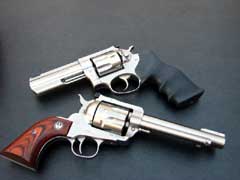
Ruger's 7-shot GP-100 (top) & 8-shot Blackhawk
(bottom) .327 federal revolvers.
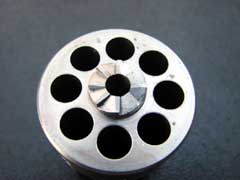
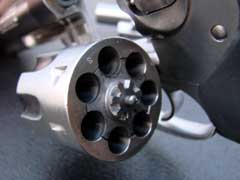
Blackhawk (top) & GP-100 (bottom) cylinders.
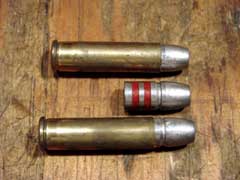
Bullets can be seated long in the Ruger cylinders to
increase powder capacity with heavy bullets like this
Killebrew 135.
Blackhawk
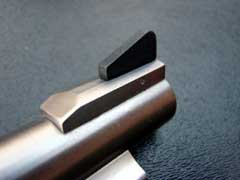
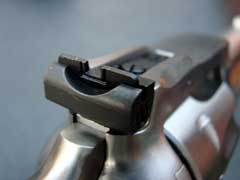
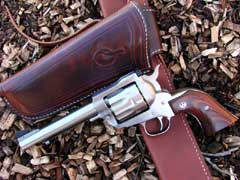
Blackhawk is right at home in this beautiful holster
& belt from Mike Barranti (www.barrantileather.com).
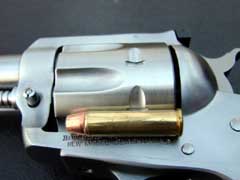
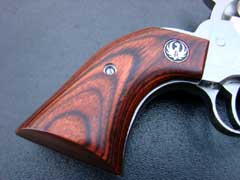
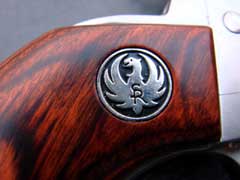

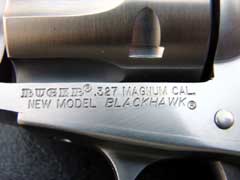



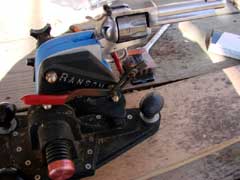
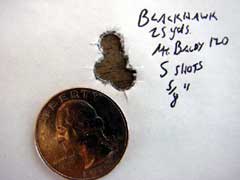
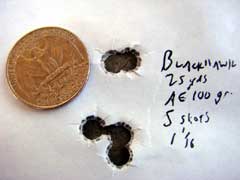

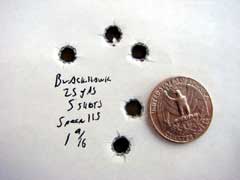
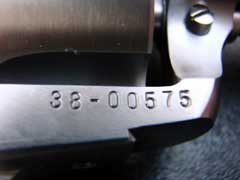
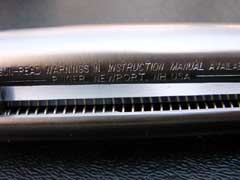

|
![]()